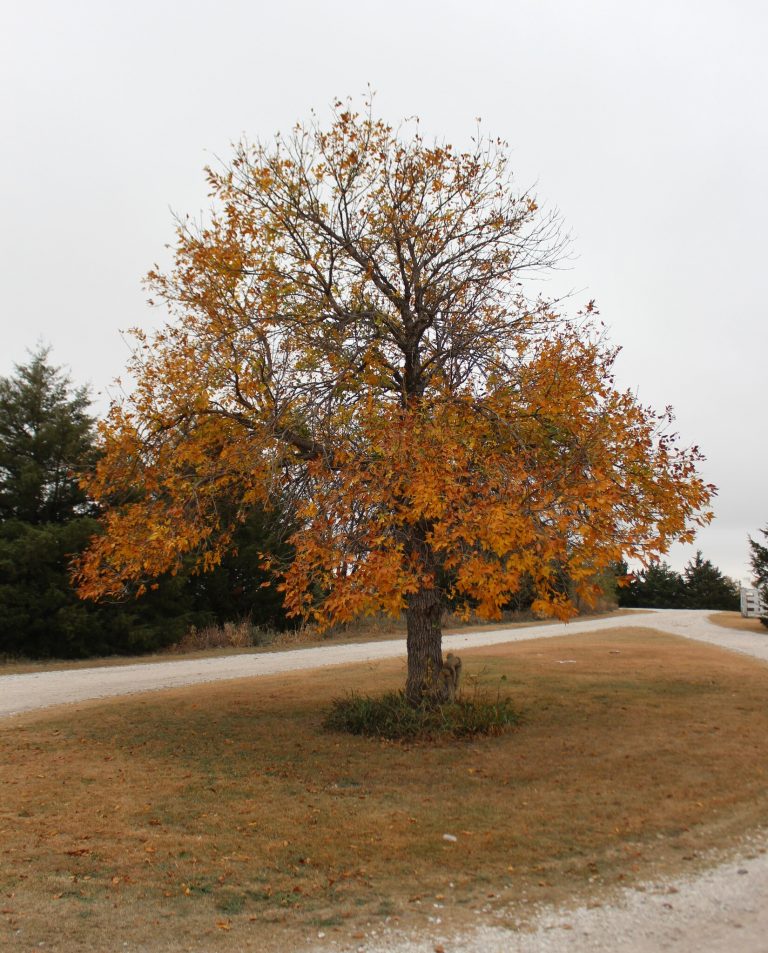By Chris Himmelwright
Pratt County Master Gardener
Pratt County Research and Extension Services
Autumn Leaves
Senescence is the technical term for the developmental processes that lead to leaf color change and death. In the case of autumn leaf color change, these processes are initiated by environmental cues: day length shortens (less sunlight to photosynthesize) and temperatures cool (signaling the plant to protect itself from freezing, cell-busting conditions). Senescence is a normal process that is controlled by the plant’s own genetic program.
Evergreens have to stick it out over the winter with their exposed leaves/needles, but deciduous plants make a costly choice to drop all of their leaves for the winter and grow new ones when environmental conditions are favorable in the spring. If leaves of deciduous plants are genetically programmed to die, what are they doing with that huge investment of plant tissue? Essentially, the plant is taking all of the valuable resources (water, sugar, minerals, proteins, carbohydrates, amino acids, etc.) out of the leaves and storing them in the main body (stems and roots) of the plant When this change (senescence) starts to happen, the chloroplast is the first organelle in the cells to deteriorate.
Chloroplasts are full of the green pigment chlorophyll, which is used in photosynthesis. When the plant stops making new food with photosynthesis it doesn’t need the chlorophyll anymore and breaks it down for storage. With the green gone, we can now see other pigments reflected in the leaf surface (red, purple, orange, yellow). As each plant is controlled by genes telling it when and how to begin storing resources, so too are the primary senescence colors for that genus and species of plant. That’s how we can recommend certain plants for red, purple, orange and yellow fall color. Breeders spend many years choosing plants with superior fall color. Selection for this trait can only occur once per year, thus finding great plants is a slow process. Fortunately, new cultivars of trees and shrubs that consistently express good fall colors are common
Soil Prep Now for Peas
Next Spring Peas can be planted earlier than just about any other vegetable crop because they can grow well at a soil temperature of 40 degrees. Though other crops such as lettuce, parsnips and spinach can sprout at lower temperatures (35 degrees), they don’t start growing well until the soil reaches about 45 degrees. However, soils are often too wet to work in the spring. Let’s hope that is true this coming year as we need the moisture. Therefore, you may wish to prepare the soil now rather than next spring so that planting can take place as early as possible even if those spring soils are wet. Wait until soil temperatures reach 40 degrees next spring and sprinkle the seeds on the soil and push them in with your finger. Protection from rabbits and deer will probably be needed as they will be attracted to anything green coming up so early.
Keep Compost Pile Moist
This is the time of year when there are lots of materials available to compost. Remember that the compost needs to be kept moist so that the bacteria and fungi can break down the raw materials. Use a sprinkler to soak through the pile to the center. Allow the pile to drain. The goal is for the pile to remain moist; not waterlogged. Edges will dry out the quickest and may need a light sprinkling from time to time.
Adapted from Kansas State Horticulture Newsletter




